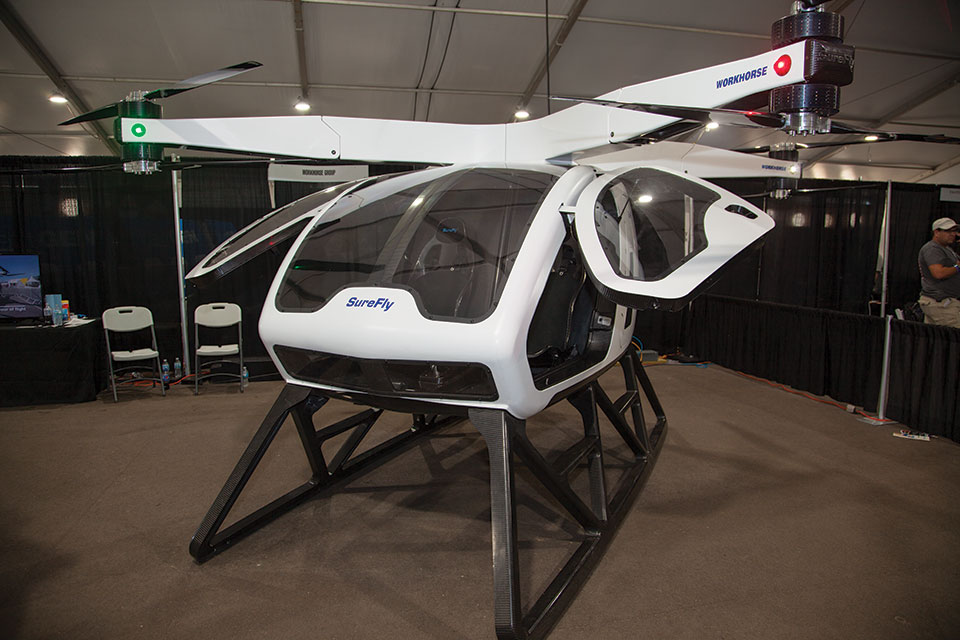Next-Gen SureFly Copter Makes U.S. Debut
By James Wynbrandt
July 28, 2017 - The next-generation, in-development personal helicopter SureFly has landed at EAA AirVenture Oshkosh 2017. Unveiled at the Paris Air Show in June, the two-place SureFly is making its U.S. debut here at the fly-in. Developed over the past year by Workhorse Group (Innovation Center), a Loveland, Ohio-based company focused on electrically powered ground vehicles, the SureFly aims to make helicopters easier, safer, and less costly to fly.
Constructed of lightweight carbon fiber, the entire SureFly airframe weighs less than 300 pounds. Four arms extending outward above the cabin each contain two motors, driving counter-rotating propellers — one above and one below — the end of each arm. Projected top speed is 70 mph, and the flight ceiling is currently planned to be 4,000 feet AGL, though it’s capable of flying much higher. When not in flight, the arms can be folded down to save on storage room, or to ease transport on the ground.
A gas-powered, turbocharged 200-hp engine drives two generators in parallel that produce the juice for the electric motors driving the propellers. The 13-gallon tank provides about an hour of flight time. In normal operation, the SureFly uses about 150 kW of power, but each 100-kW generator can supply all the power required for short periods.
“We feel this has a lot more potential than an all-electric aircraft because the utilization is much higher,” said Alan Arkus, R&D mechanical engineer and SureFly design team lead. “You can fly for an hour, put more gas in, and keep flying. You don’t have to wait for [a] charge.”
Alan said the company calculates the rotorcraft could still fly with half of the electric motors inoperative. In the event of a gas engine problem, a lithium-ion battery can provide five minutes of power, enough for a safe landing from 4,000 feet or lower. There’s also a ballistic recovery chute as further backup.
The cabin is expansive, and flight controls are simple. Rather than an instrument panel, a small touch screen sits between the two seats, as do the flight controls on a console. Designed to be much easier to fly than a conventional helicopter, a joystick controls horizontal motion, while a simple rocker switch controls ascent and descent. The prototype has a bare frame undercarriage, but the next iteration will likely have wheels to move the aircraft on the ground.
SureFly is a derivative of the company’s HorseFly, a small package delivery drone the company developed and is testing with UPS under the FAA’s aegis, and is the brainchild of Workhorse Group CEO Stephen Burns, who, like Alan, has no background in aviation.
“Our CEO thought, ‘Let’s take the type of larger vehicle technologies and combine them with drone technology, and make a drone-like helicopter that’s easier to fly, with onboard computer systems taking care of all stability control,” he said.
Workhorse expects to be flying the prototype on display here by year’s end, and Alan said, “I believe we could have a fully functional version of this within a year.”
For now, there appear to be more regulatory than technological hurdles. The company is working with the FAA to determine the best path toward certification. The agency has been “very receptive to this idea, and see us as an opportunity to develop this type of product,” Alan added.
With a projected empty weight of 1,100 pounds and max takeoff weight of 1,500 pounds, useful load is projected at 400 pounds. Equally noteworthy with the technology is the price of this helicopter: The company expects the SureFly to cost less than $200,000.
As for reaction to the SureFly here in Oshkosh, Alan said, “I’m surprised how open- minded people are to this idea. They realize the potential this has.”
Workhorse is currently taking $1,000 fully refundable deposits for the copter via its website. “We’re not going to use any money,” said Alan. “[But] enough preorders will help us secure the investment needed to take it all the way through.”

